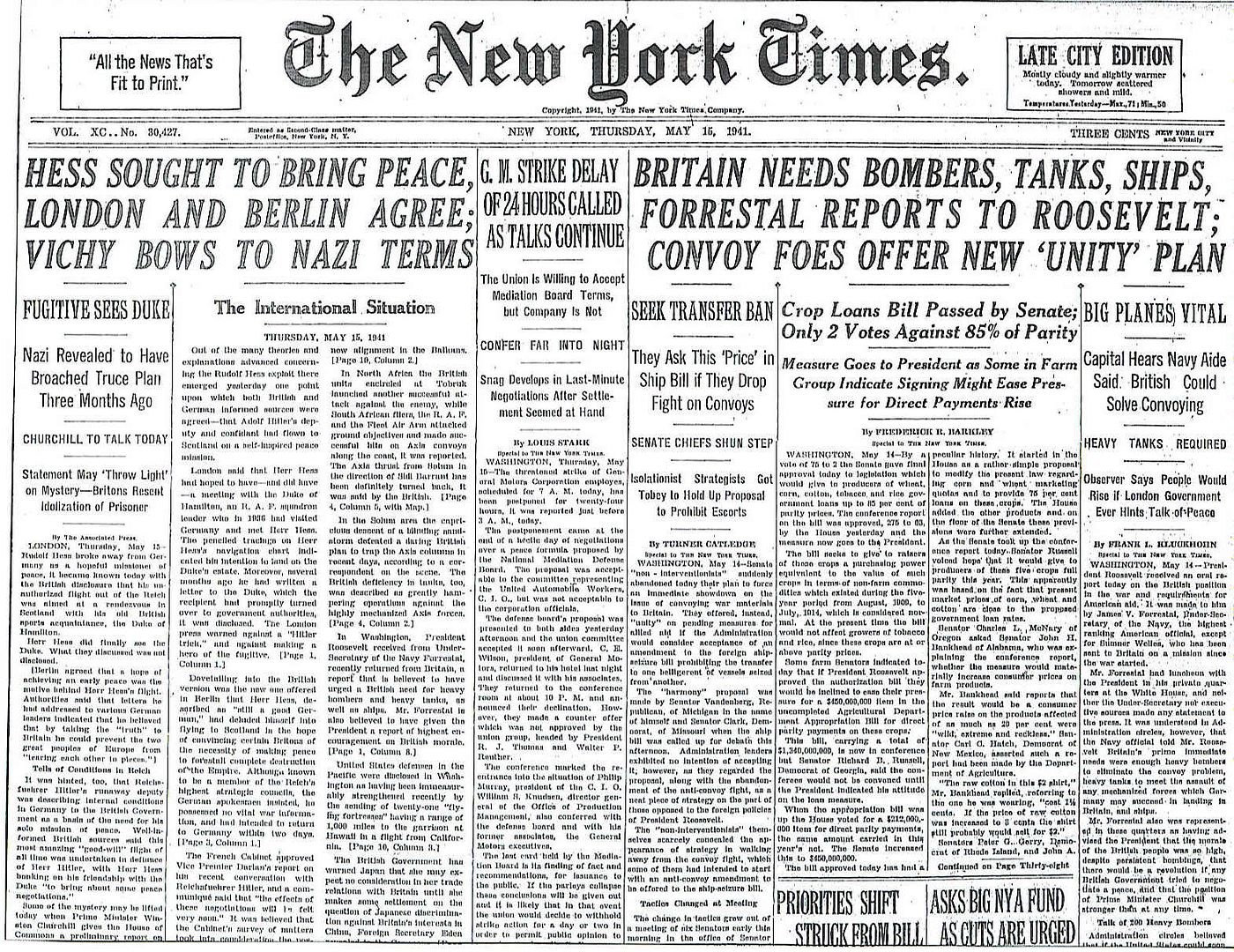
Posted on 05/15/2011 6:59:04 AM PDT by Homer_J_Simpson

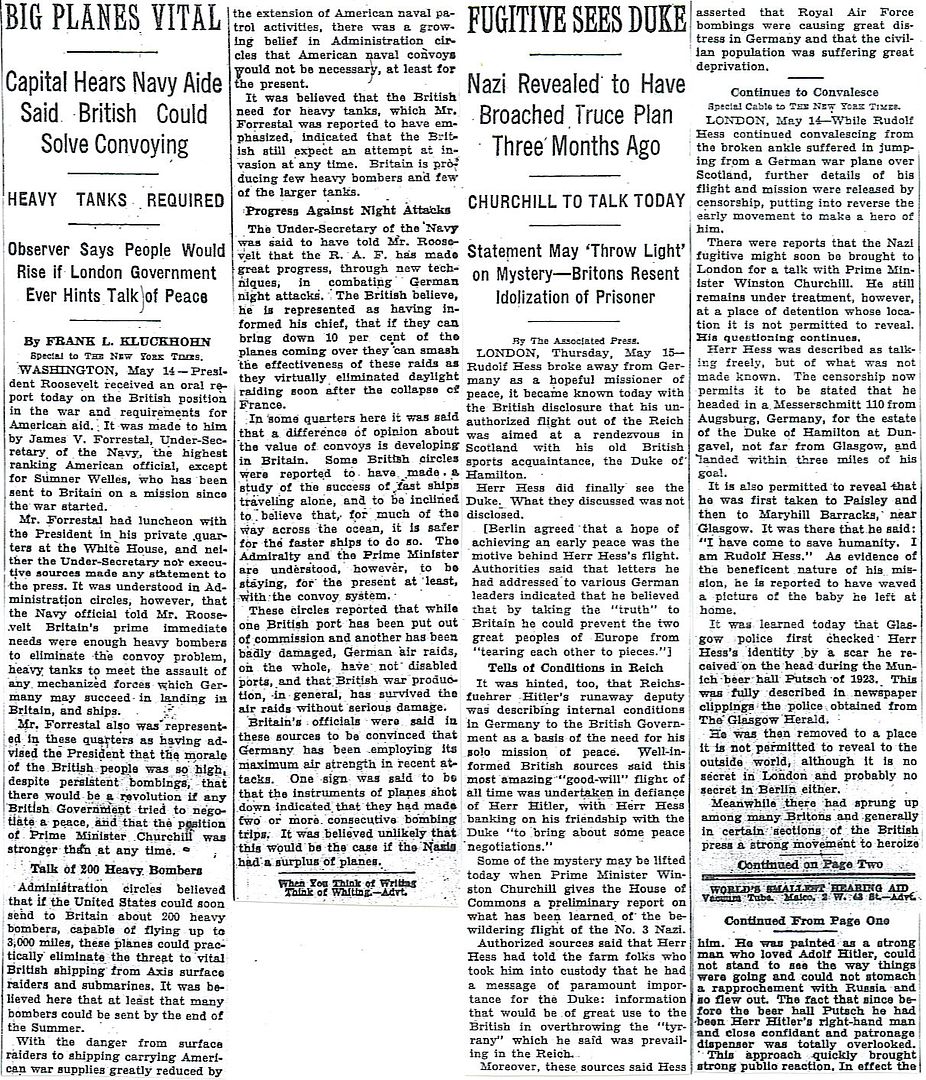
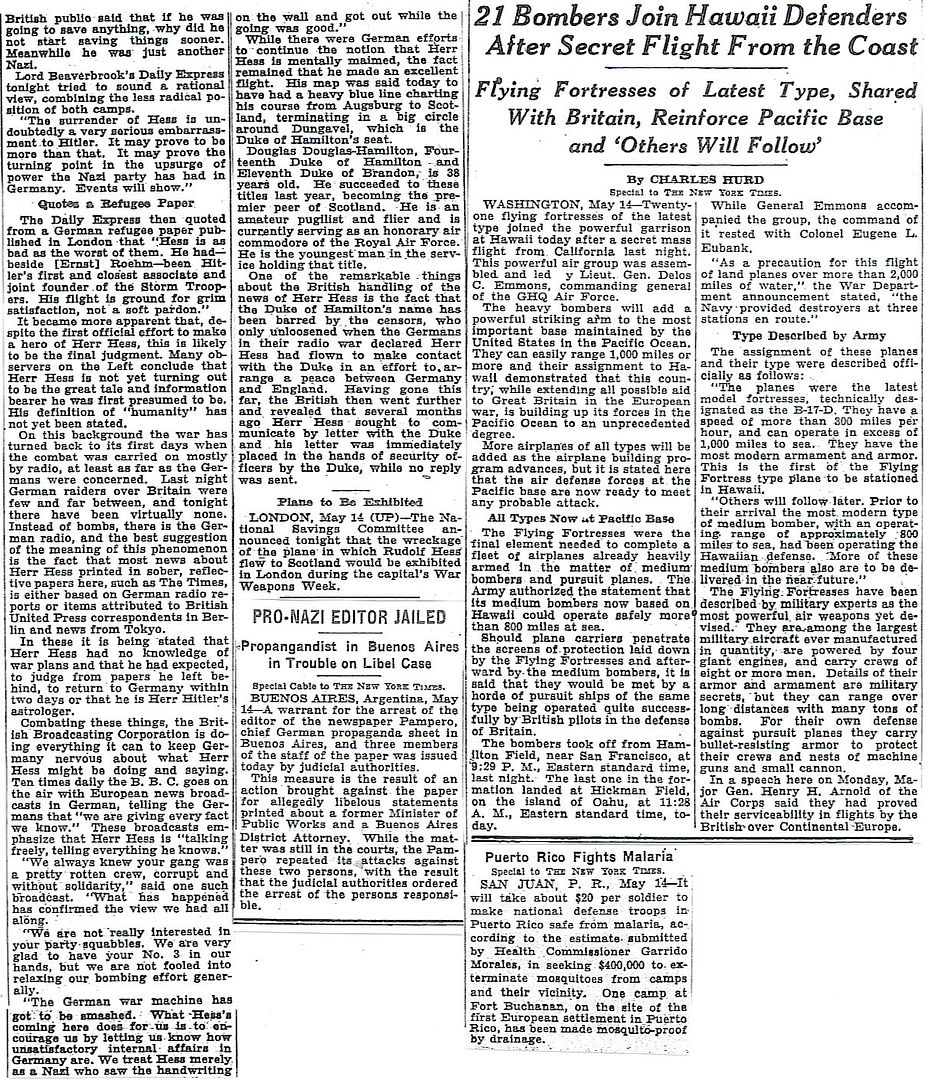
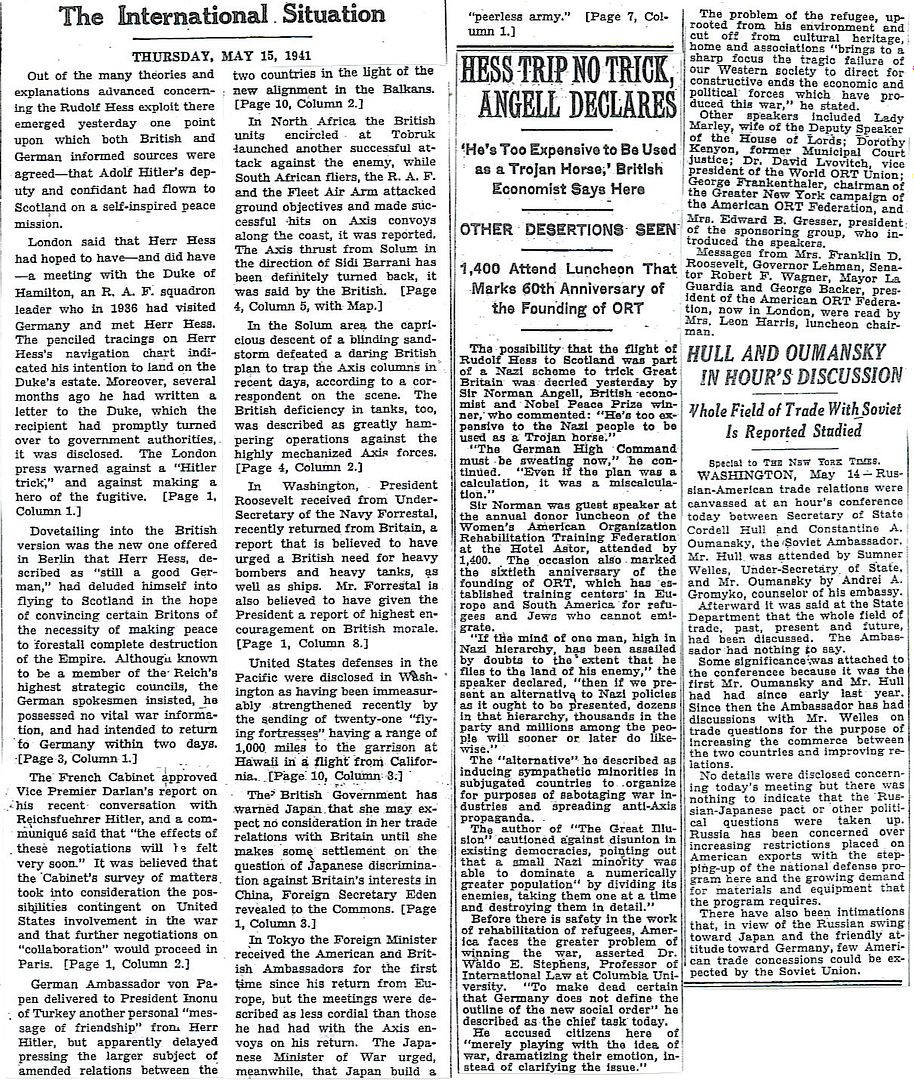
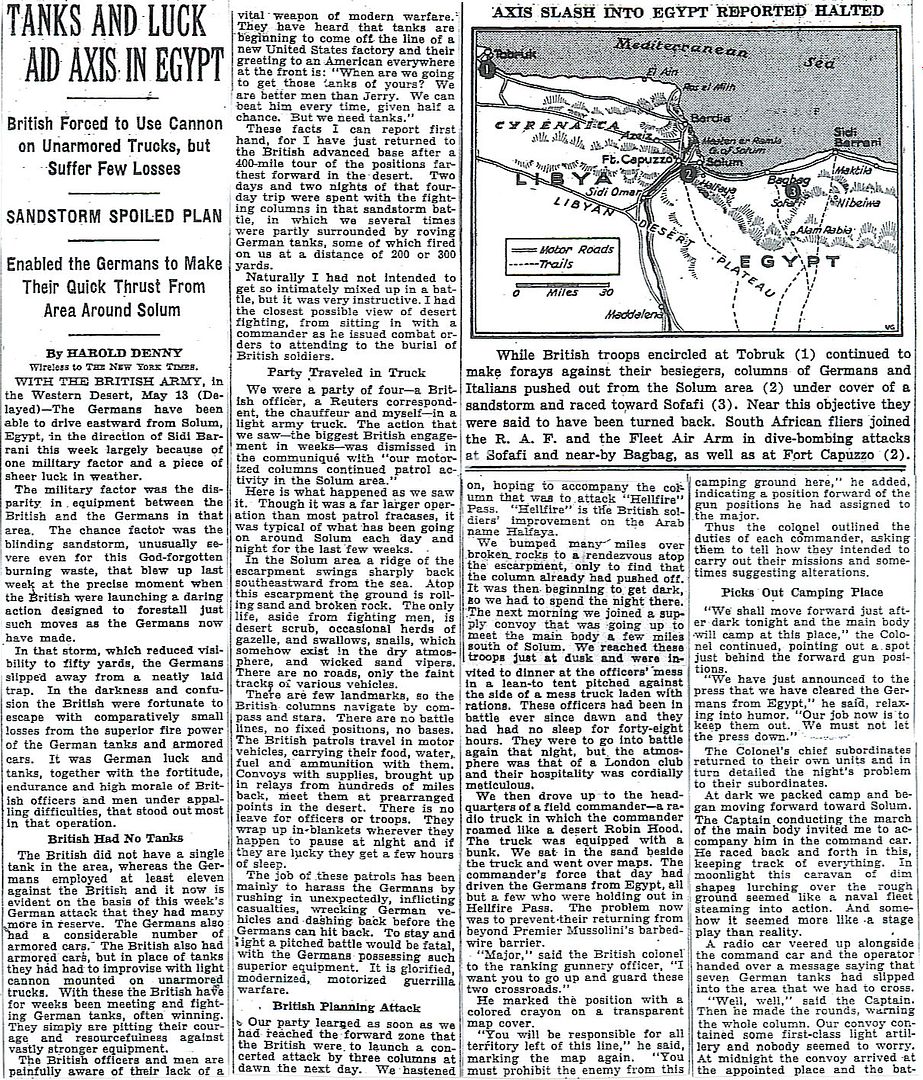

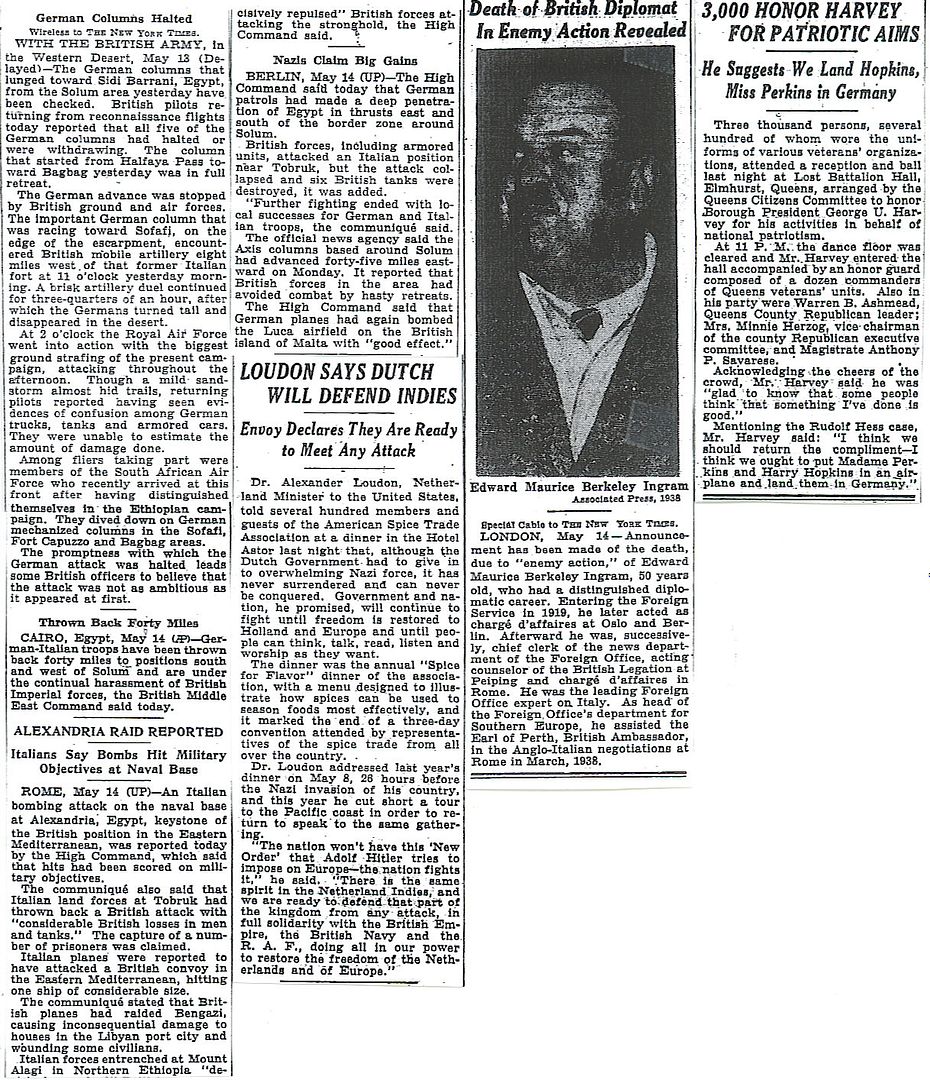
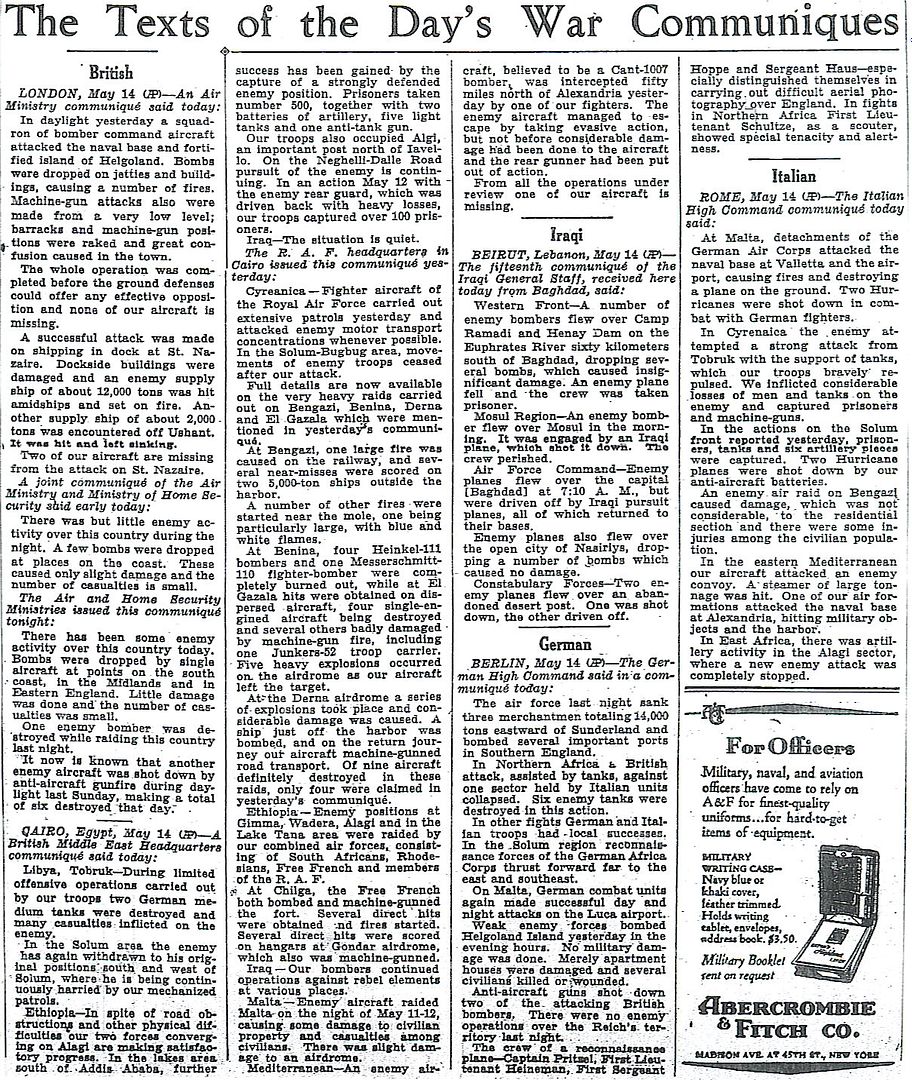
Big Planes Vital – 2
Fugitive Sees Duke – 2-3
21 Bombers Join Hawaii Defenders after Secret Flight from Coast * – 3
The International Situation – 4
Hess Trip No Trick, Angell Declares – 4
Hull and Oumansky in Hour’s Discussion – 4
Tanks and Luck Aid Axis in Egypt – 5-6
British Home Guards Mounted for the King – 6
Nazis Lose Tanks in Tobruk action – 6-7
Loudon Says Dutch will Defend Indies – 7
Death of British Diplomat in Enemy Action Revealed – 7
3,000 Honor Harvey for Patriotic Aims – 7
The Texts of the Day’s War Communiques – 8
* Well, it was secret.
http://www.onwar.com/chrono/1941/may41/f15may41.htm
British launch Operation Brevity
Thursday, May 15, 1941 www.onwar.com
In North Africa... Wavell begins an operation code named Brevity. It is designed to capture Halfaya Pass and gain ground leading to the more open areas of the Cyrenaica Plateau. The information which has been received from the interception of German signals, especially from the recent reports of General Paulus on the situation in Africa, has convinced Churchill that the German forces are weak and overextended. General Gott commands the Brevity operation. His plan calls for mixed columns to advance to Halfaya Pass and Fort Capuzzo and for a tank force to move to Sidi Aziz. On the first day the forces on the coast reach and capture Halfaya, but the 22nd Guards Brigade is held up in heavy fighting at Capuzzo. The tank force on the left makes good ground initially but the approach of the German 8th Panzer Regiment causes the British to decide to withdraw during May 16th.
In Occupied Yugoslavia... An independent Kingdom of Croatia is established with Italian backing.
From London... The British government announces that German planes are arriving in Syria and using Syrian bases to move on to Iraq.
Over Syria... The RAF bombs Palmyra and Damascus airfields. These attacks continue over the next few days.
In the Mediterranean... There are powerful German air attacks on the island of Crete. These are in preparation for the coming landing and are designed to subdue the garrison and compel the RAF to withdraw its few aircraft from Crete.
http://homepage.ntlworld.com/andrew.etherington/month/thismonth/15.htm
May 15th, 1941
UNITED KINGDOM: Cranwell: The Gloster E.28/39 (W 4041) makes its first flight. It is powered by a single 860-lb thrust Whittle W. 1 turbojet engine. This is the first flight by a British jet-propelled aircraft.
At 7.40pm today piloted by Gloster Aircraft Company’s chief test pilot, Gerry Sayer, the aircraft flew for 17 minutes.
Afterwards Wing-Cdr frank Whittle, Britain’s jet engine pioneer, said: “I was very tense, not so much because of any fears about the engine, but because this was a machine making its first flight.” Afterwards there was an impromptu celebration in the officers’ mess. Further test flights will now be made.
London: Anthony Eden informs Vichy Authorities that the RAF will attack Luftwaffe aircraft based in Syria. (Yanni Kadari)
Aircraft carrier HMS Victorious commissioned.
Corvette HMS Coltsfoot launched. (Dave Shirlaw)
FRANCE: VICHY FRANCE: Marshal Petain at Vichy announce replacement of Franco-German armistice agreement by a new collaboration scheme.
Concerning the meeting between Admiral Darlan and the Führer; Marèchal Pètain declares his complete approval. (Yannis KADARI)
GERMANY: Dr Sigmund Rascher asks Himmler for permission to carry out medical experiments on prisoners at Dachau concentration camp.
U-169, U-195 laid down.
U-577, U-578 launched.
U-577, U-578 commissioned. (Dave Shirlaw)
GREECE: The British Mediterranean Fleet is ordered to stay in the waters around Crete.
CRETE: The Luftwaffe starts bombing the island.
EGYPT: Cairo: RAF Headquarters in the Middle East announced:
On Monday, aircraft of the SAAF went into action in Cyrenaica for the first time when the RAF bombed enemy aircraft at Gambut airfield. On Monday night through to Tuesday morning, heavy English bombers overflew the Mediterranean and attacked the German airfield at Kattavia on the isle of Rhodes.
Aircraft of the Fleet Air Arm took off to attack the Al Amarah military barracks in Iraq, 48 miles from the Persian Gulf. A factory in Al Musayyib, a fuel tank in Rashid and motorised transports were likewise bombed on Tuesday. The SAAF operated without a halt. In Abyssinia their targets were Fort Aba Maela and military positions at Ama Magiihr. In Lekemti aerial machine guns fired on a motorised transport column and aircraft on the ground. Three of General de Gaulle’s Free French aircraft raided Gondar airfield (Ethiopia).
British forces in Egypt have been preparing for Operation Brevity. Their objective is to capture Halfaya Pass, utilizing the recent arrival of tanks in the Tiger Convoy. The Tiger Convoy being one of Churchill’s operations, started while he was 1st Lord of the Admirality, has given him reason to dub these tanks “tiger cubs”. This operation kicks off and initially good gains against the Axis forces are achieved.
LIBYA: A British offensive starts from the Sollum area in an attempt to relieve Tobruk and capture the Halfaya Pass. (Operation Brevity) Tanks and infantry succeed in retaking Sollum, but within hours the British are forced to withdraw leaving garrisons on the escarpment at Halfaya.
SYRIA: The RAF has bombed Luftwaffe aircraft on the ground at three airfields in Vichy-French SYRIA: Damascus, Rayak, east of Beirut, and Palmyra. General Dentz, Petain’s High Commissioner in Syria, protested last night at the raids, which were a response to German efforts to ship aircraft, tanks, and other arms to Iraq to bolster Rashid Ali, the anti-British politician who seized power in Iraq last month. (Yannis Kadari)
JAPAN: Tokyo: Richard Sorge, a Soviet spy, warns Moscow that Germany plans to invade during the third week in June.
CANADA: Corvette HMCS Sackville launched Saint John, New Brunswick.
Corvette HMCS Galt commissioned.
Corvettes HMS Arrowhead, Bittersweet, Eyebright, Fennel, Hepatica, Mayflower, Snowberry, Spikenard, Trillium and Windflower transferred to RCN and retained the same names. (Dave Shirlaw)
U.S.A.: Washington: relations between Vichy France and the United States degenerated sharply today as the senate passed a bill empowering the government to seize foreign shipping in US harbours.
Under the Ship Seizure Bill the US can take over vessels “by purchase, charter, requisition” or may take them “into protective custody.” Although not specifically aimed at Vichy, the measure is a response to Petain’s decision to collaborate more closely with Germany. Armed guards have already been placed on board all French ships in US ports, including the 83,423-ton liner ‘Normandie’. A score of French merchant ships will be put in “protective custody” as they arrive.
USN Patrol Squadron Fifty Two (VP-52) deploys to Naval Air Station (NAS) Argentia, Newfoundland from NAS Quonset Point, Rhode Island with ten PBY-5A Catalinas. Support is provided by the seaplane tender USS Albemarle (AV-5). These aircraft will fly antisubmarine warfare (ASW) patrols over the North Atlantic. (Jack McKillop)
In a baseball game played against the Chicago White Sox before 9,040 fans in Yankee Stadium in New York City, the White Sox defeat the New York Yankees 13-1. This was New York’s fifth straight loss and nobody particularly cared that Yankee centerfielder Joe DiMaggio hit a single in the first inning and drove in the Yankees only run. This was the beginning of DiMaggio’s 56-game hitting streak, a record that is yet to be broken. (Jack McKillop)
The motion picture “A Woman’s Face” opens in New York City, USA. This thriller, directed by George Cukor and starring Joan Crawford, Melvyn Douglas, Conrad Veidt, Marjorie Main and Donald Meek, is about a blackmailer (Crawford) who despises everyone because of her facial scar. After a plastic surgeon (Douglas) performs an operation to correct her disfigurement, she is torn between returning to her old life or starting a new one with a new name. (Jack McKillop)
Battleship USS Washington commissioned.
Submarines USS Amberjack and Halibut laid down. (Dave Shirlaw)
ATLANTIC OCEAN: Submarine FS Surcouf assigned to Bermuda for anti-raider patrols.
At 2029, the Benvenue, dispersed from Convoy OB-314, was torpedoed and sunk by U-105 about 420 miles WSW of Freetown. One crewmember and one gunner were lost. The master, 47 crewmembers, one gunner and six passengers (army personnel) were picked up by the Empire Trader and landed at Freetown.
After 0415, the three-masted Notre Dame du Châtelet was sunk by U-43 with 45 rounds from the deck gun and AA gunfire. The survivors abandoned ship in two lifeboats. The day before, the vessel had encountered the Italian submarine Cappellini in 47°42N/13°56W. The Italian submarine Otaria picked up two of the survivors on 23 May.
(Dave Shirlaw)
http://worldwar2daybyday.blogspot.com/
Day 623 May 15, 1941
Operation Brevity. The key to holding the border between Libya & Egypt is Halfaya Pass, where the coastal road cuts up the steep escarpment onto the desert plateau, which is currently held by Italian & German troops under German Colonel Maximillian von Herff. At 6 AM, British Brigadier William Gott leads 3 battalions in armoured cars plus 24 infantry tanks & 29 cruiser tanks along the coast and across the desert, covered by RAF Hurricane fighters. Despite skirmishes with German tanks, British capture Halfaya Pass and Fort Capuzzo by noon (taking 347 prisoners, mainly Italian). Rommel sends a Panzer battalion plus anti-tank guns from Tobruk, allowing von Herff to counterattack and recapture Fort Capuzzo by 2.45 PM (taking British 70 prisoners). Fort Capuzzo has now changed hands 7 times since June 1940.
Ethiopia. Ethiopian guerrilla forces, South African troops advancing from the South and Indian troops crossing from Gumsa Hill to the East meet at the top of Triangle, a hill adjacent to the Italian stronghold at Amba Alagi. Allied shelling of the Italian fortifications damages a store of oil which leaks into the only source of drinking water.
Iraq. An Iraqi Bristol Blenheim bombs and strafes Kingcol, British column advancing from Rutbah to Habbaniya (no damage or casualties). British Fairey Swordfish, from aircraft carrier HMS Hermes in the Indian Ocean, bomb the Al Qushla (Ottoman Barracks) in the Iraqi city of Samawah. 1 Swordfish is shot down but Lieutenant James Dundas (Fleet Air Arm air-sea rescue) wins the DSC for rescuing the crew. RAF bombers raid Vichy French airfields at Palmyra and Damascus, Syria, to prevent transshipment of German planes to Iraq.
At 8.29 PM 400 miles off Sierra Leone, U-105 sinks British SS Benvenue (2 killed; 48 crew, 1 gunner and 6 army personnel picked up by British liner Empire Trader). 430 miles West of Brest, France, U-43 shells and sinks French 3 mast sailboat Notre Dame du Châtelet which is believed to be reporting the position of U-boats (28 dead, 10 survivors abandon ship in 2 lifeboats). German bombers sink Greek destroyer Leon in Salamis Navy Yard at Suda Bay, Crete.
At midnight, British cruisers HMS Gloucester & Fiji land 2nd Battalion Leicester Regiment at Heraklion, Crete, from Alexandria, Egypt.
My father was recalled to the US Navy in early 1941 and went aboard a Pacific fleet destroyer on it’s way to the Atlantic.
So my mother gathered up the rest of us and we drove to Virginia for the duration.
I remember it well.
Did he spend the whole war on a destroyer in the Atlantic? That would be a long tour. In my day (early seventies) people switched duty stations every couple of years. I have the idea that during the war sailors often stayed on the same ship as long as it was still floating.
Rascher is a Luftwaffe doctor, infamous for the “high altitude” experiments he conducts on concentration camp inmates.
He [and his wife] will run afoul of Himmler when they steal infants from the camp and pass them off as their own [the Frau was beyond what was then considered the normal child bearing years]in an effort to impress the Reichsfuehrer SS.
Himmler has Rascher put against the wall and shot.
My dad spent about two years aboard the destroyer USS Greene, AVD 13, carrying Av gas in the N and S Atlantic to refuel sea planes. He was transfered to shore duty at Camp Shelton (near Little Creek, VA) upon reaching his twenty year mark in the Navy. Camp Shelton, at the time, was a training center for “Armed Guards” ... gunnery personnel that served aboard merchant ships. Dam Neck, at the time, was where those gun crews did their gun-firing practice ... just ashore from where German subs would attack merchant ships assembling into convoys ... From about thirty miles away, I remember seeing nighttime flashes from ships exploding off Virginia Beach.
HMS HOOD
HMS Hood was commissioned in May 1920 as a battlecruiser.
The DNC's original design description of her as a battleship never seems to have been adopted despite the fact that she was in almost every respect, except her higher speed, an equal to the Queen Elizabeth class battleships.
Given this and post-war designs it seems that the Admiralty had begun to regard 'battlecruiser' as a designation for 'fast battleship'.
Hood was, however, something of a paradox. On completion she was the largest, fastest and in many ways one of the most powerful capital ships in existence. Compared with pre-Jutland designs she was a vast improvement, partly because she was of a size that would have been totally unacceptable in pre-war years - and partly because she incorporated a substantially improved underwater protection system. However, she was still an extension of pre-war ideas and having evolved directly from the Queen Elizabeth class, did not fully incorporate the lessons of the war, particularly with regard to protection which had been improved and patched together piecemeal since the time of Jutland.
Major improvements in the design of capital ships were envisaged for post-war ships but the imposition of International Treaty restrictions over the construction of such ships soon brought these plans to an end and enabled Hood to remain one of the world's most advanced designs well into the 1930s.
Hood had an elaborate system of internal protection, which was designed to explode large calibre shells before they could reach vital equipment deep Inside the hull, but the horizontal plating was inadequate to stop plunging shells fired al long range.
Vertical protection was better,with a sloped main armour belt 12in (305mm) thick and an Integral torpedo bulge, which consisted of an outer destruction space, filled with hollow 1in. (25cm) diameter steel tubes, each 8ft (2.4m) long and sealed at either end, an inner destruction space, normally used as an extra fuel bunker,and a series of longltudinal bulkheads.
The basic problem for Hood was that work had progressed too far to enable all the lessons of Jutland to be fully incorporated while the ship was under construction, but in the inter-war years the work would have taken too long and been far too expensive. In fact, a major reconstruction for Hood was planned to start in 1938, which would have included many improvements, including better armoured protection, a much revised secondary armament and new machinery, but the threat of war and the Royal Navy's urgent need for every capital ship it could lay Its hands on resulted in the work being cancelled.
HMS HOOD was, and still is, considered one of the most beautiful ships ever built by the Royal Navy.
"Experiments" is the word that should be in quotes. From what I read in Shirer torturing people to death for fun because he can would be a more accurate description. I hope he had time to reflect on the irony of the situation while waiting to be shot.

Greene
Samuel Dana Greene, born 11 February 1839 in Cumberland, Md., was appointed acting midshipman 21 September 1855. He was executive officer in Monitor during her classic battle with ironclad C.S.S. Virginia 9 March 1862 and assumed command after his Captain Worden was wounded. He was also executive officer in Monitor in the engagements in the James River, Va., April-May 1862, and when she foundered in a gale. Commander Greene died 11 December 1884 at Portsmouth, N.H., and was buried in Bristol, R.I.
(DD-266: dp. 1,215; l. 314'41/2"; b. 30'111/2"; dr. 9'4" ; s. 34.12 k.; cpl. 122; a. 4 4", 1 3", 12 21" tt.; cl. Clemson.)
Greene (DD-266) was launched 2 November 1918 by the Bethlehem Shipbuilding Corp., Quincy, Mass.; sponsored by Mrs. John Stevens Conover. the namesake's daughter; and commissioned 9 May 1919, Comdr. R. A. Theobald in command.
Greene sailed from Newport 5 June 1919 for Brest via Plymouth, England, and returned to New York 27 July. Underway again 18 August, she put in at San Diego, Calif., 22 December and decommissioned there in March 1920. Remaining in the Reserve Destroyer Force until 10 September 1921, she sailed from San Diego that date for the Puget Sound Navy Yard. Greene returned shortly thereafter to San Francisco, arriving 2 December 1921, and decommissioned there 17 June 1922.
Recommissioned 28 June 1940 at San Diego, Greene was towed to San Francisco and was redesignated AVD-13 6 April 1941 following conversion. She sailed 27 April for the Caribbean and conducted training and tended seaplanes off Puerto Rico and Bermuda.
One week after the Japanese attacked Pearl Harbor Greene sailed for Brazil. Until the summer of 1942 she served as seaplane tender at Natal with one call at Rio de Janeiro for repairs in February 1942. She returned to Charleston 18 July 1942. She escorted a convoy from Norfolk to Bermuda and operated in the South Atlantic for the next 6 months as. a convoy escort, making two voyages to Rio de Janeiro. Back at Norfolk 26 February 1943, she steamed thence to Argentia, Newfoundland, to operate with Bogue, one of the new escort carriers designed to hunt down German submarines in the North Atlantic. Both warships sailed 23 April to escort a convoy to Londonderry, Ireland, and made the eastward passage without incident. On the return leg of the voyage, however, one of the first major engagements between carrier-based aircraft and submarines attempting a rendezvous for mass attack occurred 21-22 May when Bogue's planes made six attacks on submarines and sank U-569 in 50-40 N., 35-21 W. Twenty-four Germans were captured. During a second antisubmarine patrol from 31 May to 20 June 1943, Bogue and her escorts, including Greene, shared repeated, successes, sinking U-317 5 June in 30-18 N., 42-50 W., and U-118 in 30-49 N., 33-49 W. one week later. For these two successful antisubmarine operations Greene received the Presidential Unit Citation. The Bogue group was the first of a series of hunter-killer units which was to spell the doom of the German submarine menace.
Subsequently, until the fall of 1943 Greene escorted a fast troop convoy from Norfolk to the United Kingdom and return, and operated off Bermuda. On 5 October she sailed as carrier escort for Core in company with Belknap and Goldsborough. On 20 October the group sank E/-378 in 47-40 N., 28-27 W.
Greene returned to Charleston 19 January 1944 for conversion to high speed transport and was designated APD-36 on 1 February 1944. After intensive training she stood out 12 April for Oran, Algeria, to take part in Operation Dragoon—the invasion of Southern France. On 14 August, when she left the staging area at Propriano, Corsica, and landed American and Canadian troops on the Levant and Port Cros Islands off the coast of France between Toulon and Cannes. Greene's troops were assigned to the mission of seizing the strategic islands and silencing long range coastal batteries thought to be emplaced there. That day, the islands were secured—many of the German "guns" turned out to be stove pipes—and the stage was set for the 15 August D-day assault on the mainland.
With her tasks accomplished, Greene served on escort duty in the Mediterranean until departing Oran 6 December 1944 for Norfolk, where she put in 21 December. Underway once more 29 January 1945, the far-ranging warship steamed via Panama to reach Ulithi 31 March and commenced escort duties. During April she escorted four carriers to Okinawa while the battle for that island raged. She returned to Guam to meet another Okinawan convoy, and stood antisubmarine picket line duty off Okinawa. Until the fall of 1945 Greene continued escort duties between Okinawa, Saipan, and the Philippines. At war's end, she evacuated ex-prisoners of war from Nagasaki after that port had been razed by the second atomic bomb dropped on Japan, and moored at Okinawa 24 September.
Greene's long dynamic career came to an end in a dramatic manner. During the famous 9 October 1945 typhoon at Okinawa, winds in excess of 100 knots drove her aground on the northwest coast of Kutaka. Damaged beyond economical repair, all useful material was salvaged. She decommissioned 23 November 1945. Greene was struck from the Navy List 5 December 1945.
Greene received three battle stars and the Presidential Unit Citation for World War II service.
Fighter Aces of World War 2
Hans-Joachim Marseille
The ‘Star of Afrika’ was the fourth Luftwaffe pilot to be awarded the Diamonds to the Knight’s Cross which was Germany’s highest military decoration during World War 2. He single-handedly raised the morale of young German fighter pilots on all fronts during the war.
He was sometimes brash but was never arrogant and became a virtuoso among fighter pilots. He was a complex individual who once bragged about being the oldest Fahnrich (officer candidate) in the Luftwaffe and his superior officers had to adapt to his idiosyncrasies, rather than the other way around. He exerted greater influence than other pilots of his rank toward the end of his short career.
Marseille entered the Luftwaffe in 1938, when he was 18 years old, and completed his pilot training by 1940. He was posted to the Channel Front, but was overconfident and often said what he thought of his Squadron’s leadership. Johannes Steinhoff (178 victories), Marseille’s Staffelkapitan (Squadron Leader), quickly transferred the brash young pilot from 4JG Jagdgeschwader: Fighter Wing 52 to I/JG 2. Marseille claimed seven victories over Spitfires during the Battle of Britain, but subsequent study shows that at least five of these kills were actually Hurricanes. The Germans gave more respect to pilots who shot down Spitfires, so every British fighter shot down immediately became a Spitfire! Marseille was shot down four times during the same period-not a promising start for the future ‘Star of Africa.’ He was awarded the Iron Cross First Class in September of 1940.
Following his service with JG 2, Marseille was transferred to I/JG 27, which was deployed to North Africa in April of 1941. The Staffelkapitan with this unit, Edu Neumann recognized Marseille’s potential and turned the irresponsible fighter pilot into a deadly opponent. Lack of the fair sex in Africa also helped because Marseille was said to have been more of a lover than a fighter in France. Women played a major role in his short life. Once Marseille’s face appeared in German newspapers, he received a mountain of mail from women. He also was supposed to have disappeared with a woman in Italy before tardily returning to his unit in July of 1942.
His first victory in North Africa was a Hurricane shot down near Tobruk, Libya on 23 April 1941. Marseille was downed by a Free French Hurricane fighter pilot soon after his victory; however, he was able to land his stricken Bf 109 behind German lines. During the summer and early fall of 1941, Marseille continued to score with his Bf 109E-4 against Hurricanes 2s and Curtiss P-40 Tomahawks. I/JG 27 was soon supplied with new Bf I09F fighters and Marseille’s style seemed suited to this particular model. He-as with many other Jagdwaffe (Fighter Arm) aces - could aim better with the nose-mounted cannon and machine guns of the Bf 109F than with the wing-mounted cannon of the earlier ‘Emil.’ Marseille was awarded the Knight’s Cross on 22 February 1942 and was commissioned as a Leutnant (2LT).
His score stood at 50 aerial victories at this time. He continued to score and was known as an outstanding pilot and deflection shot. On 3 June 1942, Marseille shot down six enemy fighters in 11 minutes and was promptly awarded the Oak leaves to his Knight’s Cross and promoted to Oberleutnant (1Lt). Marseille soon outdid this feat on 17 June, when he shot down six Hurricanes and Tomahawks in seven minutes in full view of fellow soldiers on his airfield. He score stood at 101 kills and he was sent to Germany to receive the Swords to his Knight’s Cross from Adolf Hitler. He also became Staffelkapitan of 111/JG 27 as a result of his fighting qualities. On 1 September 1942. he shot down 17 RAF fighters during three sorties. All these victories were traceable in Allied loss records. He was awarded the Diamonds to his Knight’s Cross the next day. By 15 September. Marseille became the third man to score 150 victories after Gordon Gollob (150) and Hermann Graf (221).
Hans-Joachim Marseille was killed as a result of an accident on 30 September 1942. He was returning from a patrol in a new Bf 109G-2 when the engine caught fire and he bailed out, striking the tail surfaces. Marseille’s parachute never opened as he fell to the desert floor. Engine fires were frequent in early ‘Gustavs.’ Marseille had shot down 158 RAF aircraft during some 382 combat sorties. Marseille had excellent eyesight and could spot enemy fighters at extreme distance in the clear desert air.
Always critical of Jagwaffe tactics, he experimented with deflection gunnery until he developed a technique in which he closed to extremely short range, then opened fire at the moment the target disappeared beneath the nose of his Messerschmitt. The Bf I09Fs nose-mounted guns helped him perfect his deflection-shooting style. Marseille also developed equally unorthodox tactics for breaking up fighter-bomber formations at low elevation. Swooping down to gain speed. he would climb up in the blind spot under the enemy aircraft’s wing, He would then fire a quick burst of fire from 150 yds (137.2 M). and then he climbed back above the enemy formation to repeat the maneuver one more time.
Marseille was said to be able to shoot his victims down with 15 shells and bullets per victory and, much like the maverick Canadian fighter pilot George Beurling he could report the location of his strikes on the enemy aircraft! His wingman often could not follow the unorthodox maneuvers and merely stood by making note of the falling victims. There is no doubt that Marseille legitimately earned his title of The Virtuoso of Fighter Pilots, which was coined by Adolf Galland.
ACES by W Wayne Patton
Coming Next:Johnnie Johnson (RAF)
If only that were correct!
Disclaimer: Opinions posted on Free Republic are those of the individual posters and do not necessarily represent the opinion of Free Republic or its management. All materials posted herein are protected by copyright law and the exemption for fair use of copyrighted works.